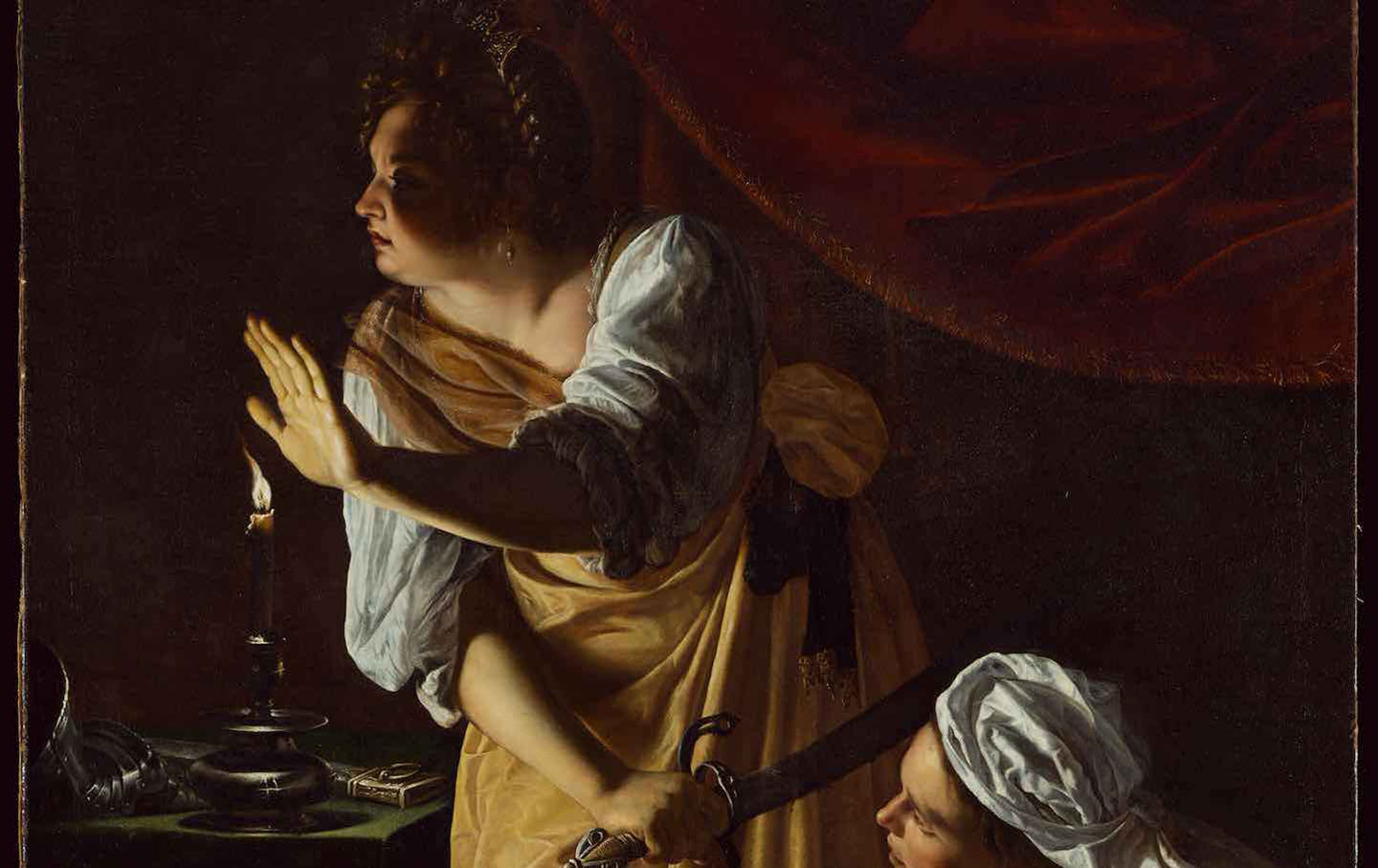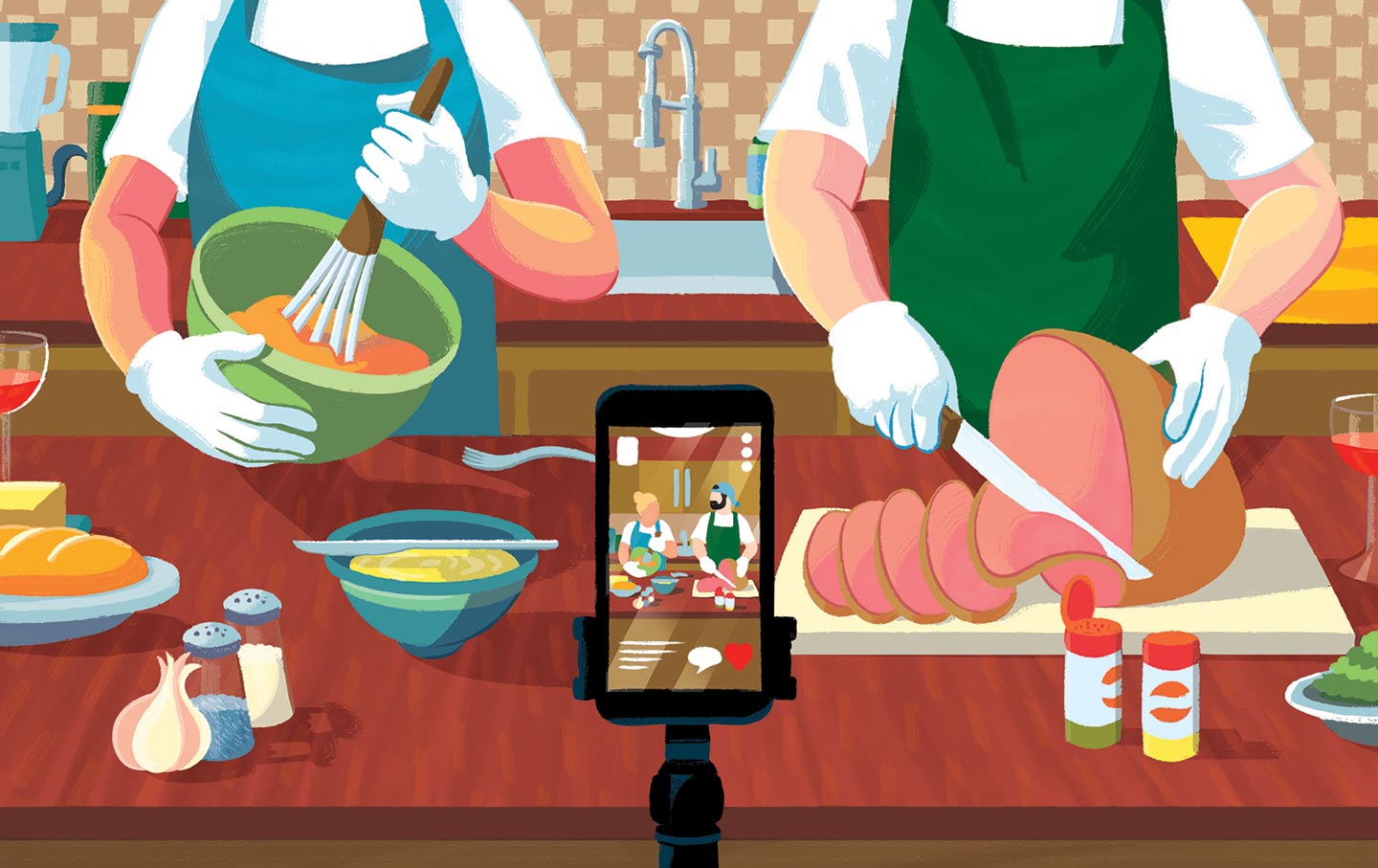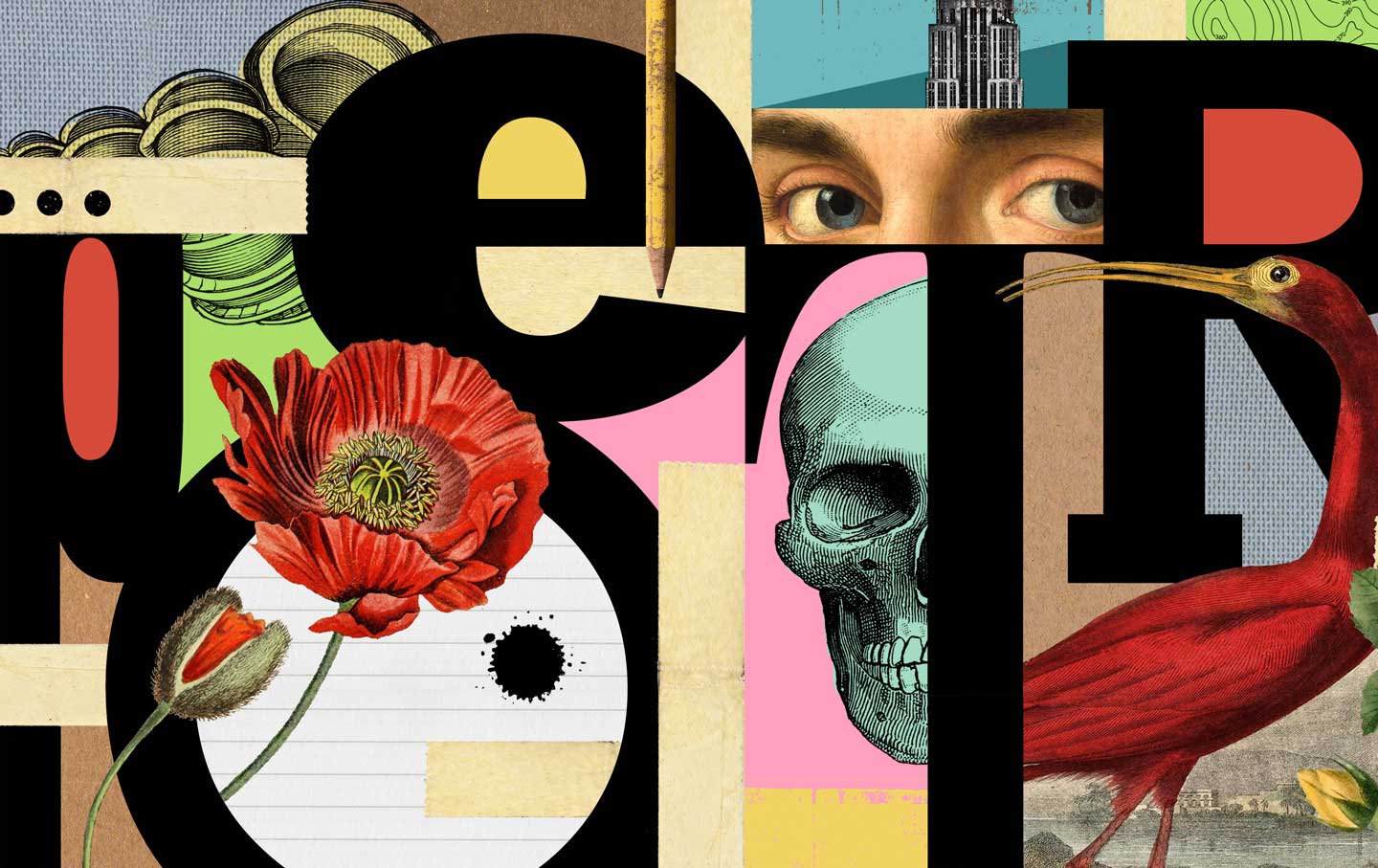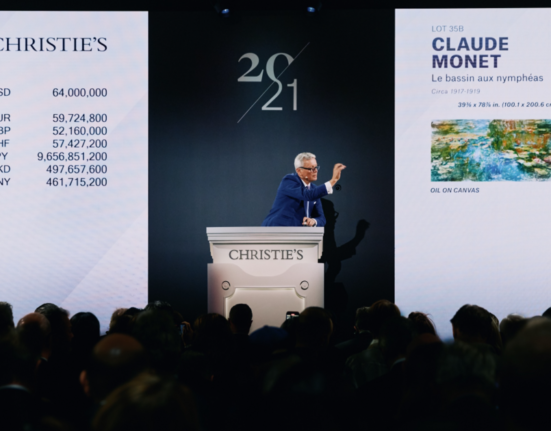
Artemisia Gentileschi’s Judith and Her Maidservant with the Head of Holofernes (detail), c. 1623–25.
(Courtesy of the Baltimore Museum of Art / Detroit Institute of Arts)
February 29, 2024
A recent exhibition documenting four centuries of art from female painters and illustrators provides a new way of looking at an era of art history where women are often left out.
It’s been more than 50 years since Linda Nochlin set the world of art history atremble. In 1971, her provocative essay for Art News, “Why Have There Been No Great Women Artists?,” shrewdly answered and deconstructed the seemingly naïve question it posed. For as Nochlin explained, “The question…is simply the top tenth of an iceberg of misinterpretation and misconception; beneath lies a vast dark bulk of shaky idées reçues about the nature of art and its situational concomitants, about the nature of human abilities in general and of human excellence in particular, and the role that the social order plays in all of this.”
Nochlin’s idea that the social order is what makes great art possible—or not, as the case may be—is as incomplete as it is irrefutable, for it fails to explain why, within a certain social structure that supports or obstructs artistic activity, some people turn out to be much better at it than others. To ascribe it to randomness, some statistical variation, is even less satisfactory than the old idea of genius. Besides, it’s clear, in retrospect, that Nochlin was hardly as free of the stereotype of the “great artist” as she would have liked to be. She explains in detail, for instance, the exclusion of women from the study of the nude—for centuries the very basis for the idea of form in painting, and therefore an exclusion from, as she says, “the necessary preparation for achieving mere proficiency, much less greatness, in the realm of art.” What she doesn’t directly contest is the idea that art—or at least great or “supremely great” art—is the work of a professional painter operating according to the academic standards of the time. By contrast, the “modest, proficient, self-demeaning level of amateurism” demanded of women artists seems to her self-evidently incapable of producing anything of lasting value.
In the wake of Nochlin’s essay, attempts to expand knowledge of women’s contributions to the history of European painting became more numerous. Notable among these, in 1979, was The Obstacle Race: The Fortunes of Women Painters and Their Work by Germaine Greer—perhaps significantly, not a professional art historian like Nochlin, but an indefatigable researcher: Reviewing Greer’s book, Nochlin found “the sheer volume of examples she presents” an obstacle to its cohesion. Nochlin, in collaboration with Ann Sutherland Harris, organized a large-scale exhibition, “Women Artists: 1550–1950,” which traveled to four American museums from 1976 to ’77; all 37 of the artists included were primarily painters.
Nochlin’s perception, in her 1971 essay, that at least through the mid-20th century, there had been “no supremely great women artists, as far as we know,” but nonetheless “many interesting and very good ones who remain insufficiently investigated or appreciated,” was well supported by these efforts, but the simple question remains: How great is “supremely great”? A few of the women painters of the past are now accorded far higher status than they once were.
It’s true that Caravaggio’s reputation as a revolutionary force in Italian art remains unmatched, but Artemisia Gentileschi now overshadows all the other artists who drew on his influence. Édouard Manet, likewise, may still be seen as the key figure in the emergence of modernism in 19th-century Paris, but among those who recognized and built on his achievement, Mary Cassatt and Berthe Morisot appear far more important today than they did 50 years ago; the specific qualities of their work, unshared by their contemporaries, have come into focus. Paula Modersohn-Becker outshines most of her German Expressionist colleagues. And while Jackson Pollock remains the Abstract Expressionist par excellence, Lee Krasner and Joan Mitchell are now better appreciated than some of the male painters who were once accounted as his near-equals—Franz Kline, for example. Is just plain old “great” not great enough without the “supremely” added like a cherry on top?
I’m as happy as anyone can be for the chance to enjoy the work of a great artist, or a supremely great one, or even just an almost great one. I’m just as grateful to be reminded of how much beauty and pleasure we sometimes overlook in our frantic hunt for the great. Some of that beauty and pleasure has been brought into the world by those “interesting and very good artists” who were hoping to achieve greatness and didn’t quite make it; but much more, perhaps, came from the hands of “modest, proficient” amateurs who never intended to conquer fame but simply to please themselves and the people immediately around them.
That, at least, is my takeaway from “Making Her Mark: A History of Women Artists in Europe, 1400–1800,” which I recently saw at the Baltimore Museum of Art. The show was curated by Andaleeb Badiee Banta, Alexa Greist, and Theresa Kutasz Christensen, and will also be shown in Toronto at the Art Gallery of Ontario from March 30 to July 1. Here, at last, was an exhibition illuminating—more than Nochlin and Harris’s relatively more conventional “Women Artists” exhibition could have done—what Nochlin called “the nature of art and its situational concomitants…the nature of human abilities in general and of human excellence in particular, and the role that the social order plays in all of this.”
That this would not be a show of “great painting” but something quite different was announced, in a sly way, at the very entrance, where its title and introductory wall text were highlighted by an imposing, elaborately carved wooden frame, more than 10 feet high and six and a half feet wide. This turns out to be the show’s first exhibit: Created in London around 1671, it was meant for a judge’s portrait; the painting no longer exists, but the frame is still here. Its maker was named Mary Ashfield, and she was one of the many women engaged in frame-making in London at the time. She earned £12 for this piece of work, which now lacks its original gilding.
Like this imposing frame, quite a few of the most outstanding things in “Making Her Mark” are marginal to the category of art as conventionally understood but nonetheless the work of highly skilled professionals. Among the show’s most fascinating pieces are its many examples of botanical, zoological, and other types of scientific illustration. These include published engravings, but many of the most striking examples are unique watercolors: for instance, those created by Giovanna Garzoni (who was also a painter of some prominence) in 17th-century Rome, or by Elizabeth Blackwell, who in the 18th century compiled a herbal—in order to pay off her husband’s debts—based on specimens in London’s Chelsea Physic Garden, which is still in existence today. On the basis of her watercolors, Blackwell created the hand-colored engravings and etchings for a book she published in 1739.
Such botanical illustrations demanded great precision and carried a great deal of information about their subjects, but they also offered their makers great scope for invention, and even a kind of disciplined fantasy. Blackwell’s work, in particular, is of a breathtaking delicacy. But more than that, her images practically vibrate with life. Most extraordinary of all, perhaps, is her vision of a yellow asphodel, with its long, slender, sinuously meandering leaves, which look as if they are drifting about languidly in some fluid medium. If you Google this plant today, you might find that it “features a clump of narrow, linear, grassy, gray-green leaves to 12 [inches] tall”—but how drily austere that sounds in comparison to the oddly seductive vision of this plant that Blackwell offers.
Another memorable watercolor of putatively naturalistic purport is one attributed to Johanna Helena Herolt-Graff, a German specialist in botanical illustration who worked in Amsterdam and later moved to the Dutch colony of Surinam. She learned from and collaborated with her mother, Maria Sibylla Merian, who was best known for her illustrations of caterpillars, and with her sister. Seen as a piece of scientific illustration, Herolt-Graff’s Three Mice Nibbling Fruits and Nuts (ca. 1690–1710), presents a quandary: Are the plants the main subject, or the hungry animals? I’d say it’s neither, but rather the at once destructive and sustaining act of eating itself, which in this hyper-real image (almost hallucinatory) appears both sinister and paradisiacal, like some lost detail from Hieronymous Bosch’s Garden of Earthly Delights.
A step beyond scientific illustration are the uncannily realistic porcelain flowers made, circa 1748, at the Manufacture Nationale de Sèvres in France by an atelier of female ceramicists and painters under the direction of Marie-Henriette Gravant. These minutely detailed little knickknacks were, it seems, a particular delight of the king’s mistress, Madame de Pompadour. From the wall label, we learn that she enjoyed “perfuming them to create the scented illusion of a garden indoors.” Today, without this aroma, they exude a surreal sense of petrified life.
Artists like Blackwell and Herolt-Graff were professionals whose intensity of vision lent their ostensibly pragmatic and utilitarian art a beauty and strangeness unaccounted for by the information it was designed to convey. But there’s also plenty of genteel amateurism on display, which transcended the limited scope of its makers’ ambition. Occasionally, the same person could play both roles. One example is Anna Maria Garthwaite. On the one hand, she was a hugely successful designer of silk textiles in 18th-century London; her opulently rococo art is represented in “Making Her Mark” by watercolors, swatches of fabric, and full garments. But her most striking work in the show was unrelated to this profession. It was something that must have been done as a hobby: an intricate but folksy silhouette image in black paper, showing—as it was described when auctioned at Christie’s in London in 1993 (it now belongs to the Victoria and Albert Museum)—“an English manor house, within fenced gardens and extensive woodland landscape, with gardeners, huntsmen, horses and carriages, deer and hounds, a church and village to the west of the house.” All that, in a finely cut sheet not much more than 15 inches across, in a naïvely geometrical style that couldn’t be further from the rich floral curves of Garthwaite’s textile design patterns. Whatever her reason for creating this piece, it was very distinct from her commercial endeavors.
In spirit, Garthwaite’s silhouette is closer to the flat, highly patterned representations found in many embroideries, samplers, and other examples of craftwork that were considered suitable pastimes for virtuous women and girls. Take a work bag made in Britain in 1669 by a 10-year-old with the initials I.S., a marvel of patience as well as of fine stitchery. Also presumably the work of a devoted amateur is an amazingly elaborate piece of quillwork—filigree made of rolled paper—made in the 18th century, though who knows where or by whom. It’s essentially a ridiculously ornate frame, about 11 by 14 inches, for a tiny picture (a disc of about an inch and a half in width) of the Madonna and Child. Quillwork, we are told, was considered “an affordable way to decorate everything from reliquaries to furniture, altarpieces, and small works for both personal devotion and domestic decoration, like this example.” And while it may have been materially inexpensive, how dear must have been the time spent on it!
But with this anonymous piece, I find myself back at my starting point: a frame becoming more important than the painting it’s meant to set off or supplement. It thus evokes, like it or not, the philosopher Jacques Derrida’s famous paradox of the parergon, the framing or supplement that is purported to be secondary to the artwork itself but turns out to be essential. Need it be pointed out that this accords with the position of women in relation to art, at least during the period covered by “Making Her Mark”? At best, somewhere on the edge of art, somewhere around it but not quite in it—involved in an activity with a certain similarity to art but either too personal, too amateur, or else too much of a business enterprise, never quite properly artistic.
That’s not to say, of course, that the exhibition does not also include its fair share of things that are unmistakably high art, above all history paintings like the two interpretations of a biblical story that one might, if one wished, take as an allegory for woman’s revenge on her male oppressor: Judith with the head of Holofernes. As painted in 1596 by the Milanese artist Fede Galizia, Judith exhibits a strange serenity beside her decapitated Assyrian foe. But her elderly maid looks on with an expression of perplexity, and the composition creates an ambiguity about the three hands that surround the severed head and the platter below: the hand cradling the tray must be the servant’s, the hand holding the head by its hair ought to be Judith’s, and yet it never becomes quite possible to see it that way without forcing oneself, imposing narrative logic on a recalcitrant visual puzzle. Artemisia Gentileschi’s version, painted around 1623–25, is an altogether more dramatic—and dramatically lit—composition. But this Judith doesn’t bother with the head she’s just severed; with a strange gesture toward the single candle illuminating the scene, she seems to hush its light, while leaving the cleanup to the ever-dependable maid.
Popular
“swipe left below to view more authors”Swipe →
Just as the frame can overpower the painting, “Making Her Mark” turns the tables on a few centuries’ worth of established artistic hierarchies, fulfilling Nochlin’s call for equality in a way that Nochlin herself—because she could not question the idea of “that total inner confidence, that absolute certitude and self-determination, moral and esthetic, demanded by the highest and most innovative work in art”—could not succeed in doing. In that sense, the exhibition represents a late (albeit not a moment too soon) consequence of the great wave of second-generation feminism. But it’s not only Nochlin’s (and Greer’s, and so many others’) determination to recover the memory of so much silenced effort by so many women that has finally made such an exhibition possible. It’s also reflective of a broader shift in our sense of what the very word “art” means.
That shift was certainly caused, in part, by that same second-wave feminism, which generated a passionate interest in forms of creativity that had previously been deemed sub-artistic, categorized as craft rather than art, and often practiced by women. It was also a product of the rise, starting in the late 1960s, of what can now be called conceptual art: a new way of looking at things according to which, at least under certain circumstances, functional everyday objects, images meant to convey empirical information rather than aesthetic feeling, and images that reiterate already existing imagery (like the many works in the show based on drawing exercises and textile pattern books) can have the same artistic status as unique paintings and sculptures. Think of Lorraine O’Grady’s 1983 work Art Is…, in which performers framed the spectators of an African American Day Parade on Adam Clayton Powell Boulevard in Harlem, turning everyone into an embodiment of art. It’s this expansion of the possible range of reference of the word “art” that helps make it possible to see today the artistic value of china plates, lace, and so many of the other objects in this exhibition.
In the catalog for “Making Her Mark,” its project is described—in implicit contrast to Nochlin’s accent on the “supremely great”—as a search for “the unexceptional woman artist.” I think that might be misguided. I’m not sure art of any sort can be made in the absence of an impulse to be exceptional—and this exhibition proves it. For some, the arena in which one strives to achieve distinction may be, as it was for Gentileschi, the apex of European society, or it might be a small circle of intimates. As we all know, time has a way of leveling those differences. May the leveling continue.
Can we count on you?
In the coming election, the fate of our democracy and fundamental civil rights are on the ballot. The conservative architects of Project 2025 are scheming to institutionalize Donald Trump’s authoritarian vision across all levels of government if he should win.
We’ve already seen events that fill us with both dread and cautious optimism—throughout it all, The Nation has been a bulwark against misinformation and an advocate for bold, principled perspectives. Our dedicated writers have sat down with Kamala Harris and Bernie Sanders for interviews, unpacked the shallow right-wing populist appeals of J.D. Vance, and debated the pathway for a Democratic victory in November.
Stories like these and the one you just read are vital at this critical juncture in our country’s history. Now more than ever, we need clear-eyed and deeply reported independent journalism to make sense of the headlines and sort fact from fiction. Donate today and join our 160-year legacy of speaking truth to power and uplifting the voices of grassroots advocates.
Throughout 2024 and what is likely the defining election of our lifetimes, we need your support to continue publishing the insightful journalism you rely on.
Thank you,
The Editors of The Nation









